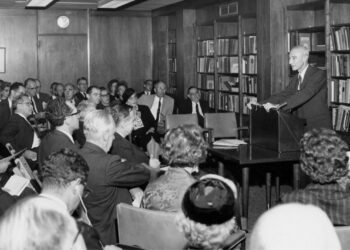
It seems that we hear about new efforts to reposition the scholarly monograph for an open environment almost every day: services such as Knowledge Unlatched, programs like Luminos, imprints like Lever Press, and research such as “Mapping the Free Ebook Supply Chain”. AAU, AAUP, and ARL have taken a collective interest, not “as a response to a crisis in either the humanities or in publishing [but to] establish a sustainable publishing workflow designed to expand access to and engagement with humanities scholarship.” If you are not already directly engaged, this is at least a space worth watching.
This summer, Project MUSE announced that it is developing its ability to host and distribute open access (OA) ebooks. This initiative, called MUSE Open, is supported by The Andrew W. Mellon Foundation with more than $900,000 in funding. Project Muse’s announcement is a major development in monograph publishing generally and more specifically in the possibility of their shift to OA. I was pleased that Project MUSE’s director Wendy Queen was willing to speak with me recently about this program and some of the broader strategic issues we should be contemplating.
MUSE Open will rely on payments from publishers to support its business. Wendy emphasized that the business model, which is not yet ready for release, will offer a variety of different options or approaches. Since OA income is unlikely to be “repeatable,” I was led to believe that MUSE Open’s model will similarly offer a one-time payment option for publishers.
The lion’s share of the platform investment being made is not in any way specific to open books, but will “improve the reading experience of the monograph broadly.” These investments are required in large measure because open ebooks do not necessarily have print equivalents, which represents a different set of assumptions and interface requirements than for traditional monographs which necessarily appear in print. By providing a “post PDF” set of workflows and user experience, Wendy expects MUSE to strengthen its experience for users of all its content.
Wendy hopes that these investments will, over time, make it possible for MUSE to play a key role in moving the monograph beyond a digitally accessible text to taking greater advantage of the potential of the online environment. While journal articles generally remain static PDFs or their equivalent, perhaps there is greater opportunity for the monograph, given the emerging commitments to rethinking scholarly communications for the humanities. Wendy spoke of a number of opportunities to reach with and through its publishers to authors, to build platform features that would better enable them to address their audience in, for example, the digital humanities.
In this regard, it was very interesting to hear Wendy’s overall view on the aggregator environment. She sees the strategies being pursued by EBSCO and ProQuest, to build, buy, or support the creation of a full array of services for libraries to acquire and manage their collections as being about the “processes of content.” MUSE is not pursuing this type of strategy so much as it is trying to help authors and publishers begin to rethink the nature of “content itself.” The array of specific service opportunities and implications for an author and publisher centered aggregator strategy, as opposed to a library (and reader?) centered strategy, are clearly key.
MUSE has worked hard to ensure that it provides a single platform for all its content, journals, books, and future formats such as reference alike. In this regard, a key principle is to treat all “content and distribution equally and in a sustainable and fiscally responsible manner.” For example, open content will receive the same level of investment in terms of features such as identifiers, altmetrics, and annotations.
Wendy told me from the beginning of our conversation that she would come back again and again to the phrase “content connections,” and she did not disappoint. On one level, this represents some very important opportunities to build discovery connections, such as recommenders, across the full sweep of the content the platform and beyond. Given the opportunities to unleash value for users, content, and platforms, discovery is important.
But I came to understand that Wendy also sees content connections as an issue of special strategic significance in contemplating the shift in distribution of ebooks from traditional to open models. Right now, monographs from most university presses are distributed digitally through multiple online platforms — the same ebooks can appear in MUSE, ProQuest, and other services, just as the same print books can be ordered through YBP, Coutts, and Amazon. This has met libraries’ demands to be able to purchase books on the platform of their own choosing. But should OA monographs take hold, the content distribution marketplace might be expected to flip from libraries licensing ebooks from a preferred platform to publishers paying to place their books on a content platform.
In such a case, will publishers be willing to pay multiple times to ensure distribution through multiple platforms? With OA journals, publishers typically control their own platforms and avoid paying for secondary distribution. Wendy believes that another form of content connection will be to link together ebook platforms so that books can be discovered and used via multiple aggregators while only being deposited into and distributed by a single platforms. This is an intriguing vision that, on Wendy’s telling, relies on the further development of linked open data, presumably in addition to a shift beyond from competition and towards greater collaboration among aggregators. It is a vision that would take us beyond the relatively clean separation of discovery service and content platform that we have thus far seen develop under the leadership of EBSCO and ProQuest. I was left wondering if there is a realistic opportunity to build, from a user’s perspective, the single library collection that the bevy of separate digital platforms have systematically fragmented.
On a final note, we spoke a little bit about why MUSE is making an investment in open now. Wendy was straightforward in saying that MUSE is seeing at this point a “modest” level of interest “trickling in” from its publishers, rather than an avalanche of demand. But, with today’s NEH and other support for OA monographs, along with Mellon’s systematic interest and growing interventions in recent years, MUSE sees momentum building. Having the technical and business capacity to support such a transition may be the smart investment.
Discussion
2 Thoughts on "Open Ebooks Coming to Project MUSE: An Interview with Wendy Queen"
When director of Penn State University Press, I was eager to enter our journals into Project Muse’s system, which i knew all about because Johns Hopkins had hired our former journals manager, Sue Lewis, to collaborate with Michael Jensen in setting up Muse. When Muse opened its journals program beyond its own journals in 2000, Penn State was the first press to sign up. Later, as a member of the Muse advisory board, I strongly urged Muse to open itself to monographs and to do so in such a way as not to silo the monograph from the journal content since much value could come from searching through both bodies of material at the same time. Muse took this advice and wisely set up a system to “connect content.” It is great to see this vision now further developed through the addition of OA monographic content. And the vision appears to anticipate the kind of new document beyond the book that Robert Darnton wrote about back in 1999 (“The New Era of the Book”) when he inspired the launching of the ACLS Humanities EBook project and Gutenberg-e. One major financial problem identified by Kate Wittenberg in her review of Gutenberg-e, which she headed, was the failure to recognize the need for the development of templates, so that each new project did not require de novo, customized treatment. Another problem was the refusal of some major scholarly review media to accept these “books” for review, since there could be no exact print counterpart. We may hope that this resistance has been overcome by this time. It will remain a financial problem, however, that there can be no revenue generated from POD sales to help support the creation of these new types of monograph.


